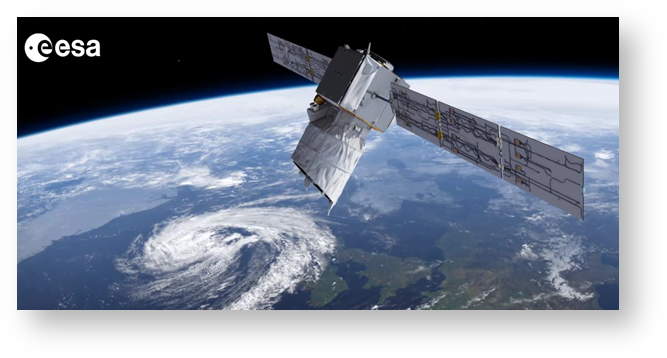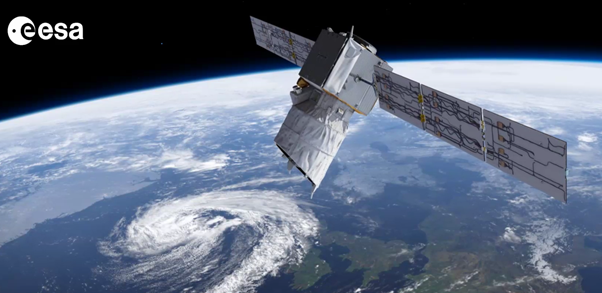Example of Aeolus Rayleigh-clear Level-2B HLOS winds |
|---|
Introduction to Aeolus
Aeolus was the fifth satellite in the Living Planet Programme of the European Space Agency after being launched on 22 August 2018. The mission's
Background on Aeolus
ADM-Aeolus is the second of ESA’s Earth Explorer core missions. The objective is to provide profiles of high-quality wind observations from the surface to 30 kmthe lower stratosphere, using a Doppler wind lidar (DWL) instrument (known as ALADIN) in a near-polar sun-synchronous, dawn-dusk orbit at around 320 km altitude. The wind information is the horizontal line-of-sight (HLOS) component, in the direction perpendicular to the satellite track's velocity. The mission is intended to have a surpassed its minimum lifetime of three years (lasting nearly five years) after de-orbiting on 28 July 2023.
ECMWF is leading the project to develop Aeolus Level 2B/C processing software, that is, wind retrieval and data assimilation of Aeolus winds, and to implement the processing within ECMWF as part of the mission ground segment. The L2B wind retrieval algorithms have been developed in collaboration with KNMI, Météo-France, DLR and LMD/IPSL. Aeolus also provides information on cloud and aerosol optical properties (the L2A product). ECMWF has also contributed to a number of data impact studies to assess the potential of the Aeolus data. We expect the Aeolus mission to have a positive impact on forecast and analysis quality, in particular for the tropical winds.
The L2B processing softwarecontracted by ESA to develop, in collaboration with KNMI, DLR and other partners of the Aeolus DISC the Aeolus Level 2B/C (L2B/C) processing software i.e. the wind retrieval. ECMWF generated the NRT L2B products during the mission lifetime via the L2/Met PF (Level-2/Meteorological Processing Facility; a part of the mission's Ground Segment). The products were disseminated to ESA for further distribution to users. ECMWF also convert the L2B Earth Explorer format products to a WMO approved BUFR format and forwarded them to EUMETSAT for further distribution to the NWP/research community via the GTS and EUMETCast.
ECMWF operationally assimilated the Aeolus L2B wind observations in ECMWF's global NWP (Numerical Weather Prediction) model from 9 January 2020 to 30 April 2023. The L2B winds were proven to improve forecast skill and operational assimilation was justified, despite being a demonstration mission. Aeolus winds have a positive impact on analysis and forecast quality, particularly in the tropics and polar areas, particularly where conventional wind profiles are absent. The intention is to hopefully use reprocessed datasets in future ECMWF produced reanalyses.
Given that ALADIN is a High Spectral Resolution Lidar, it is also possible to derive information on atmospheric composition: cloud and aerosol optical properties (particle backscatter and extinction coefficients, via the Level-2A product). This is also being researched at ECMWF for the benefit of the CAMS model.
Further information and publications on Aeolus:
- See ESA's website on Aeolus
- Aeolus on twitter
- QJRMS article about the NWP impact of Aeolus at ECMWF: https://doi.org/10.1002/qj.4142
- A conference proceedings article on some of the demonstrated scientific benefits of Aeolus: https://ieeexplore.ieee.org/abstract/document/9554267
- ECMWF web articles about ECMWF operationally assimilating Aeolus winds:
- An ECMWF Technical Memorandum on Aeolus: https://www.ecmwf.int/en/elibrary/19538-nwp-impact-aeolus-level-2b-winds-ecmwf
- An ECMWF newsletter article about the impact of reprocessed wind data:https://www.ecmwf.int/en/newsletter/173/earth-system-science/aeolus-positive-impact-forecasts-second-reprocessed-dataset
- Aeolus was launched on 22 August 2018; this website provided a log of progress on the satellite up until launch: https://aeolusweb.wordpress.com/
- Aeolus-specific conferences:
- A CAL/VAL rehearsal workshop took place in March 2017 and the presentations can be found via this web page: http://www.aeolus-calval-2017.org/
- CAL/VAL rehearsal L2B and L2C datasets are available here
- Aeolus CAL/VAL and Science workshop 2019
- Aeolus CAL/VAL and Science workshop 2020
- Aeolus 3rd anniversary conference in 2022
- Aeolus Science Conference 2023
- A CAL/VAL rehearsal workshop took place in March 2017 and the presentations can be found via this web page: http://www.aeolus-calval-2017.org/
- Documents prepared for ESA regarding the L2B/C processing are available here; which might be useful to help understand the L2B products
- Browse the available Aeolus data from ESA's ground segment
- Automated Aeolus L2B data quality monitoring at ECMWF (no longer useful after the end of mission)
- Monthly Aeolus L2B quality reports by ECMWF (search for Aeolus)
- An introductory talk on Aeolus winds from the EUMETSAT/ECMWF NWP-SAF Satellite data assimilation training course: 03_SAT_TC_Aeolus_winds_MR_v2023.pdf
- An introductory talk about Aeolus L2B winds (possibly now obsolete): Aeolus_L2B_winds.pptx
- A talk on Aeolus NWP impact from the Aeolus Science conference 2023: ECMWF_NWP_impact_Aeol_winds_Rennie_Rhodes_sci_conf.pdf
The L2B processing software
KNMI and ECMWF develop the Aeolus Level-2B wind retrieval software, the main output of which are HLOS wind observations, which are ECMWF and KNMI are responsible for the development of the ADM-Aeolus wind retrieval software (the Level-2B processor) which produces winds suitable for use in NWP and meteorological research. The algorithms were desribed in Tan et al. (2008), however there have been many changes since then.Refer to the Algorithm Theoretical Basis document for information about the algorithms (see documentation links below).
Downloading the L2B processing software and documentation
- The The ADM- Aeolus Level-2B/C processing documentation (including the Software Release Note, the Algorithm Theoretical Baseline Basis and the IODDInput/Output Data Definitions Interface Control documents) and associated datasets (useful for installation testing) can be freely downloaded from hereneeded to test the success of the installation) is available for download:
Button Hyperlink title Download Aeolus L2B/C documentation and datasets type standard url L2B processor documentation and datasets - The source code can be obtained from here freely downloaded from from our website (upon acceptance of the licence terms):
Button Hyperlink title Download Aeolus L2B processor package type standard url http://www.ecmwf.int/en/forecasts/software-and-tools/software/aeolus - News Any news on updates to the software will be , e.g. planned deliveries, is provided here
- Technical notes related to the L2B/C processing can be downloaded here
Example of Aeolus L2B Rayleigh-clear wind results
- Aeolus L2B winds have a WMO approved BUFR template:
- Some guidance for NWP users on the L2B BUFR data
An example of real Aeolus L2B HLOS winds, from an orbit just to the west of hurricane Dorian on 1 September 2019:







